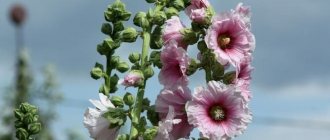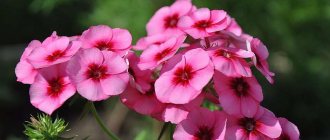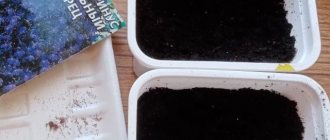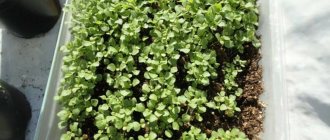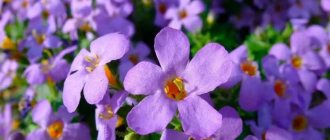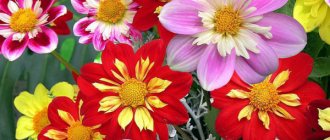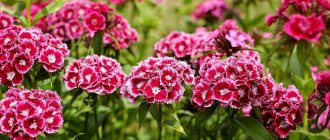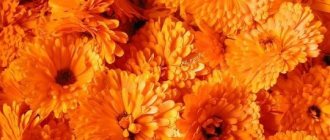Nasturtium is a versatile flowering plant. It can be grown as a decorative plant, used as a vegetable or seasoning, to “scare” pests in the garden with it, and also used for medicinal purposes. You can grow nasturtium at the dacha and in flowerpots on the balcony, in a pot among the greenery in the kitchen and in the apothecary garden. Its bright aroma allows it to be used as a flavoring agent for oils; besides, insects cannot tolerate it at all, and this property can also be used in the garden and in everyday life. How to grow nasturtium from seeds, how to properly plant it as seedlings, where to use it and how much effort it will require to grow is the topic of today’s conversation.
Let's get to know each other better
The second name of the plant is capuchin because of the shape of the inflorescences, which have an external resemblance to the outline of a monk’s hood. This is a herbaceous crop that is grown as an annual in mid-Russian latitudes. In shape it can be grass, subshrub or bush; there are also ampelous species with soft long shoots that can reach 4 m. The color palette is bright, carnival, with a predominance of warm tones. Currently, breeders have developed many varietal varieties and hybrids, including those with semi-double and double flowers, and presented in variegated colors. The flowering of capuchin lasts almost the entire summer, including the warm period of autumn.
Nasturtium is a natural fungicide. Many insects cannot stand its smell, so it can perfectly cope with the role of a garden “orderly”.
Diseases and pests treatment
Although the nasturtium plant is unpretentious, it can also be susceptible to disease. Diseases that may affect nasturtium include wilting, the appearance of spots on the leaves (gray, brown, brown, black). In this case, treatment is carried out with special drugs. Diseased bushes or stems are destroyed (burned) so that the causative agent of the disease disappears. There are different ways to combat aphids:
- sprayed with a weak solution of alcohol with added soap;
- spray with warm water, which is infused with tobacco.
The most popular types of nasturtium
Botanists count about 90 species of this genus. In addition to the basic species, there are many hybrids, which are mainly grown in culture.
Nasturtium Canarian (foreign)
A variety of ampelous form, the vine of which can grow up to 3 meters or more. It has good tenacity, can climb along a support, and is used in vertical gardening of gazebos, balconies, arches, etc. The stems are densely leafy, which makes it possible to use nasturtium of this type as a ground cover when growing horizontally. It blooms with bright yellow inflorescences with decoratively corrugated petals. In the conditions of central Russia, the seeds of this species do not ripen.
Golden ball
A compact and neat variety of nasturtium, valued for its abundant flowering. The flowers are golden yellow, varieties can be double or semi-double. Each bush blooms up to 10 or more inflorescences at the same time. In addition, this varietal variety is a real champion in terms of flowering duration. Used for borders and growing on balconies and terraces.
Large nasturtium
This species served as the basis for breeding work, which resulted in the creation of many new varieties and hybrids. It has a long and extremely fragile stem, which must be touched with great care. This variety also includes varieties with bushy shoots, in which case they grow much shorter, usually no more than 50-70 cm. The best varieties of large nasturtium:
- “Alaska” is a semi-shrub species up to 30 cm high. The flowers are large, deep pink or bright yellow. The leaf rosette is dense, the leaves are decorative, with a marbled color.
- "Vesuvius" is a variegated, low-growing variety with an interesting color. The petals are pink with multiple burgundy strokes.
- “King Theodore” has deep red buds, but simple, non-double type.
- “Salmon baby” is a semi-double varietal variety of ampelous type with salmon-colored buds.
- 'Peach melba' is a delightful hybrid with soft peach flowers set off by a reddish center.
Nasturtium cultivated
Under this name, hybrids obtained from crossing large and shield-bearing nasturtium are combined. The very fragile and highly branched stems of this species can be colored plain green or purple-brown. There is a big difference between the sizes of varieties and, of course, between the colors and shapes of their buds. Among them there are liana-like, dwarf, and tall bush capuchins.
The best varieties of cultivated nasturtium:
- “Gleming Mahagani” is a variety with neat compact bushes about 40 cm and terry buds of a fiery red color.
- "Golden Globe" - stands out strongly from other nasturtiums with spherical flowers of a shape that is not quite traditional for the culture. It blooms in yellow-golden color, forms a low clump up to 25 cm.
- “Moonlight” is a climbing varietal variety whose vines reach 2 m in length. The inflorescences are semi-double, pale yellow or moon-white.
Small nasturtium
As the name implies, it is characterized by more compact forms. Produces low-growing bushes with thin and fragile stems, while the leaves stretch towards the sun on long petioles. The buds are also small in size and often have a variegated color. The two most famous and popular varieties of this species are:
- “Cherry Rose” is a wonderful double variety with double buds painted blood red.
- "Black corduroy" - flowers of a very dark burgundy color, shining black. This variety is sometimes called "Black Lady".
Reproduction
Since nasturtium is grown as an annual crop, it is propagated mainly by seeds. Planting material ripens well and remains viable for 3–4 years. Nasturtium seeds are medium-sized, covered with a ribbed shell and look like a nut. When unripe, they are pickled and used in cooking as a substitute for capers.
Collect the seeds after the fruit capsules turn light brown and are easily separated from the stalk. The collected fruits are laid out in a dry place, dried and peeled. Store seeds in cardboard boxes or fabric bags.
Nasturtium can reproduce by self-sowing. But early spring seedlings often die from frost. Self-seeded plants bloom only at the end of summer for only a few weeks.
Very rarely, nasturtium is propagated by cuttings. This method is used to obtain new plants from the best specimens of perennial species. The queen cells are left to overwinter in a bright and cool room, occasionally watering them. In spring, cut cuttings easily take root in water or wet sand.
Use for pest control
In order for growing nasturtium in the country to have not only an aesthetic, but also a practical purpose, you should be guided by the following recommendations.
- If you plant nasturtiums around a bed of cabbage, then its harvest will be well protected from cabbage butterflies and whiteflies.
- To protect greenhouse tomatoes from pests, it is recommended to plant nasturtium near the entrance to the greenhouse.
- Capuchin flowers planted next to peonies will protect them from fungal infections.
- Nasturtium grown in their tree trunks is very beneficial for cherry and apricot trees. This will not only force pests to avoid this place, but will also enrich the soil with substances useful for the growth and development of these crops. When preparing the garden for wintering, it is enough to bury the plant remains of flowers in the same place where they grew.
- And if you use the remains of last year’s nasturtium in the spring to apply it to an area intended for planting potatoes, then the future harvest will have enhanced protection against late blight.
When growing nasturtium outdoors in pots (for example, on a balcony), possible winds must be taken into account. Fragile shoots easily break with any gust of wind, and in hanging varieties they become hopelessly tangled. You should not plant capuchin in open areas and balconies on high floors.
How to care for seedlings
When caring for seedlings, it is hoped that in a short period of time an independent plant will grow from a small seed. Each stage of cultivation has certain care rules.
- At the stage of seed germination, the containers are covered with plastic film or glass. This is an additional requirement that activates the germination process due to the accumulation of condensate inside the structure and maintaining a certain temperature. It may take 10 to 15 days before the first shoots appear. During this period, the top layer of soil is moistened with a syringe or spray several times.
- After the sprouts appear, additional coverings are removed. Containers are placed on the windowsill to provide access to sunlight. The air temperature should be set between +18 and +22 °C. Growing flowers are watered regularly as the top layer of soil dries.
- Light intake is of paramount importance when growing. The duration of daylight should be from 12 to 16 hours. With a lack of light, the sprouts tend to become very elongated. Caring for tall seedlings when grown in open ground areas is quite difficult. They will stand out from the total mass of seedlings, gradually weaken and stop growing.
How to grow nasturtium?
Since the crop is annual, it will have to be grown from seeds. It is possible to grow nasturtium both through direct sowing in open ground and through seedlings. The seeds of the plant are quite large, so planting them is easy.
How to plant and grow nasturtium seedlings correctly?
The time for planting seeds for seedlings is April. Seedlings grow quickly and are very fragile, and the root system is not very strong, so do not rush into early planting so as not to create problems with the future transfer of seedlings to open ground. You can calculate the timing of planting, taking into account the local climate, so that within a month after sowing it is possible to transfer the seedlings to the site.
It is best to practice growing crops such as nasturtium in peat tablets or cups. In the latter case, no more than 2-3 seeds are placed in each glass; if there are more shoots, the excess ones can be cut off with scissors. Planting depth is 1.5-2 cm. You should not place the box with seedlings in a hot place, the capuchin does not like this, but there should be plenty of light, otherwise the seedlings will stretch out unsightly. Care is carried out traditionally.
How to pick nasturtium?
It is best not to do this at all due to the increased sensitivity of the plant to mechanical stress. When planting is dense, excess bushes are removed using scissors.
Planting in open ground
The recommended sowing time is the third ten days of May, but the timing should be adjusted taking into account the region and seasonal weather. The nesting method is recommended for planting. The layout of the planting holes is about 20 cm, 3-4 seeds are planted in each of them. To speed up germination and protect against possible night frosts, you can cover the bed with film. Water the seedlings on the site with water heated in the sun.
A month after planting nasturtium, it will be possible to get its young edible shoots for your vitamin table.
Planting seeds for seedlings
The advantage of growing through seedlings:
- early flowering;
- germination guarantee;
- strong healthy seedlings.
Flower growers have invented a variety of methods for sowing seeds, each of which has its own advantages and gives excellent results.
Traditional way
This method is no different from sowing seeds of other annual flowers and has two options.
- The seeds are placed in a common container. When 3-4 true leaves appear, the seedlings dive into separate pots. The downside is the fragile stems and roots of nasturtium, which are easily damaged during transplantation.
- Sowing in individual containers. The soaked seeds are placed in cups, peat tablets, pots, buried 1-1.5 cm into the soil.
Nasturtium seeds are large and spreading them is not difficult.
In both cases, the container with planted flowers is covered with plastic film, a bag or glass and placed in a warm place with a temperature of 20-22 degrees.
Planting in sawdust
An unconventional method - germination in sawdust - is suitable for subsequent picking. In this case, the sprouts are easily removed and are not damaged.
Sawdust is placed in a container in a layer of 3-3.5 cm. Pour boiling water over it until completely moistened. Sawdust should not be allowed to float in the water; the substance should be loose. They should just be wet.
Make holes in hot sawdust at a distance of 4-6 cm and place dry grains in them. Pre-soaking them is not required with this method of planting.
Place bags over the container and place them in a warm place for germination. The seeds do not need light at this stage. The container is transferred to a sunny place after 5-6 days, when the first shoots appear.
When all the seeds have sprouted and 2-3 full leaves appear on the sprouts, they are transplanted into separate containers. The seedlings are quickly and without damage removed from the loose sawdust.
For the base, use sawdust from deciduous trees or compressed sawdust pellets for filling cat litter boxes. In conifers, due to the high resin content, the seeds will not germinate.
Growing nasturtium without soil
To be sure of the emergence of seedlings, the seeds are pre-germinated. No soil is required for this.
Cotton wool is spread into the container and watered with water with the addition of a growth stimulator. Seeds are placed on wet cotton wool at a distance of 2 cm from each other. Cover the top with another layer of cotton wool or cotton pads. The liquid should saturate both layers of cotton wool, since seeds require a lot of moisture to germinate.
After the first shoots appear, the seedlings are placed in separate cups. It is recommended to do this with tweezers, as the sprouts are very fragile.
A clean and replant-free way to grow seedlings is to sow them in peat tablets. Maintenance of the plantings in them is minimal, as only watering is required. All nutrients are already in the filler.
- Place the tablets in a tray.
- Pour warm water for 30 minutes.
- Drain excess liquid from the pan.
- Deepen the seeds 10-15 mm into the recess of the tablet.
- Cover with plastic.
Plant seedlings directly with the tablet. This is the most gentle way of growing.
Landing in the "snail"
A popular way to obtain seedlings is in “snails”. Rolls are made with earthen soil or replaced with paper napkins or toilet paper.
To do this you will need:
- strip of dense polyethylene or backing for laminate size: 10 cm x 100 cm;
- toilet paper or napkins. Their quantity should be enough for 2 layers along the entire length of the film strip;
- 2-3 rubber bands for banknotes, rope or tape;
- round container.
Roll making process:
- Unfold the plastic on the table.
- Place paper over it.
- Dilute 3 drops of Epin in 1 liter of water and moisten the napkins.
- Spread dry seeds 4-5 cm apart, 15 mm from the edge. This will be the top edge.
- At the end, leave 10-15 cm without seeds.
- Roll the tape into a tight roll, making sure that the seeds do not move.
- Secure the film with tape, rubber bands or twine.
- Place the “snail” in a container with pre-filled warm water.
- Cover the top with a bag to create a greenhouse effect.
To make a roll of soil, soil is laid out instead of paper. All other actions are the same.
After green sprouts appear, the bag is removed and the bucket with the roll is placed in a bright place.
When 2-3 leaves grow on the seedlings, picking is necessary. To do this, the “snail” is placed on the table and carefully unfolded. The seedlings do not have to be pulled out or divided. All roots remain intact and easily take root in a new place.
Selecting a location
When choosing a place to grow nasturtium, there are two conflicting factors to consider. On the one hand, the flower loves places open to the sun, on the other hand, it is afraid of winds. In the shade, flowering will be faded and sparse, and when there are gusts of wind, the stems break very easily. Regarding the soil, the wishes boil down to good drainage, light structure and low acidity. You should not overly stuff the soil with organic matter, this will give an undesirable advantage towards green mass instead of flowering. But too poor lands will not give the desired result. The foliage will be small, and the planting will look half-bald, with the soil showing through.
Nasturtium seedlings grown in low light conditions subsequently suffer for a long time after being transplanted into the ground and may not produce color.
Possible problems
Problems may arise during the seed germination and growing stages. Seeds may not germinate in the following cases:
- The expiration date of the seeds has expired, the seeds are poorly dried, and so on;
- the soil did not warm up, but planting was rushed or overnight frosts suddenly occurred;
- the soil is too wet and poorly drained;
- the planting material turned out to be buried in the ground more than necessary.
There are not many problems with growing nasturtium from seeds, but you should still remember the following:
- Grow in a well-lit place, preferably avoiding drafts.
- The soil should be fertile with good drainage. This will ensure good growth and lush flowering.
- Before flowering, the plant needs to be fed and watered abundantly.
- Avoid excess moisture in the soil. The roots will rot and the plant will die.
- Check for the presence of pests and treat them promptly if they appear.
Caring for nasturtiums in the garden
In many aspects of agricultural technology, the crop can be classified as unpretentious, however, one should remember that it is intolerant of cold weather and gusts of wind.
Watering
The peculiarity of the plant is that at different periods of its life it requires a different approach to hydration. From the time of planting until the flowers open, watering needs to be stable and plentiful, but with the obligatory high-quality drainage of excess water. But, as soon as the first buds begin to open, the watering regime should be reduced almost by half, since excess moisture is detrimental to flowering. If nasturtium is grown in a pot, arranging a full drainage layer is mandatory.
Top dressing
The area under nasturtium should be fertilized according to the general schedule, during the spring preparation of the plot and subsequently before flowering begins. As soon as the first buds open, fertilizing stops. In the mineral complex, the emphasis should be on phosphorus, but with a minimum nitrogen content. Capuchins are very responsive to feeding with ash; after this, the color palette becomes especially bright.
How to tie nasturtium?
If a hanging variety of nasturtium is planted on the site, care must be taken to ensure that it does not fall under the weight of the shoots. Despite the fact that liana-like species usually easily cling to supports and rise upward, any load can destroy this unstable structure. The branches need to be tied with a wide ribbon (bandage, torn pieces of material, etc.), without tightening the knots or pressing them tightly against the support elements.
Nasturtium - beneficial properties for the garden
It is recommended to plant them in the garden or next to vegetable plantings in order to combat and prevent cabbage, Colorado potato beetles, aphids and others. It is believed that the smell of the plant attracts pests, thereby the vegetables remain undamaged.
Nasturtiums are planted next to garden trees. Set aside a small space in the beds with cucumbers, tomatoes, cabbage and other vegetables. You can plant along the paths next to the future harvest, thereby providing protection and pleasing yourself with contrasting colors.
Nasturtium diseases
If this flower has relatively reliable protection from pests, then with diseases everything is much more complicated. It is not uncommon for it to suffer from bacterial wilt, putrefactive infections and rust. Among the diseases of nasturtium seedlings, the most dangerous is black leg, the virus of which can also infect neighboring seedlings. Very often you can observe that nasturtium leaves turn yellow. There may be several reasons for this, and the simplest is mechanical damage to fragile stems. Also, the plant often suffers when planting thickly. At the same time, its root part may rot, and the leaves may turn yellow.
How to choose a container for planting?
You can grow nasturtium in a small container that can fit 2-4 holes. To plant the seed, you can use peat pots or containers with a movable bottom. The best choice would still be a container intended for planting in the ground along with the seedling. It has the ability to be processed independently, while fertilizing the seedlings. The soil for future foundations must be light and have good air permeability. You can use peat, sand and turf in equal proportions. Also, the soil should not be acidic. If there is too much organic matter in it, nasturtium will produce a lot of greenery, but not inflorescences. If, on the contrary, there is little organic matter, then there will not be many inflorescences.
Use in food
Everything that is above the ground in nasturtiums is edible. The taste of the stems, leaves, flowers and fruits of the plant differ from each other, but have something in common. Something a little like mustard seeds and watercress, but with a light sweetness that doesn’t overwhelm the overall taste. The younger and smaller the leaves and flowers, the tastier they are. All this is added to soups, sauces and salads, and used as a vitamin supplement. Old leaves and shoots have a harsher taste, but can be used in soups, minced meats, and side dishes.
Nasturtium flowers are a wonderful edible decoration for holiday dishes and formal side dishes.
Care
Watering
The large mass of green leaves and stems requires regular watering. Young plants especially need water during the growth period and in dry, hot weather. An adult nasturtium can easily tolerate short breaks in watering. Surprisingly, a plant torn out of the ground does not wither for a long time and continues to bloom - it is helped by the moisture accumulated in the succulent stems. After watering, the soil around the plantings is loosened and weeded.
Feeding
Nasturtium does not tolerate fertilizers with fresh organic matter and is responsive to phosphorus-potassium fertilizers. Nitrogen fertilizers are best used as foliar sprays. It is useful to treat young plants 1–2 times with a solution of urea or humate. The nasturtium bushes will become strong, the leaves will be powerful and bright green. Plants are fed with complex mineral fertilizers every 4–6 weeks.
How to prolong flowering?
Flowering of nasturtium begins 1–1.5 months after emergence and lasts until frost. To ensure long flowering without interruptions, faded flowers are regularly plucked off - this stimulates the formation of new buds. Only those inflorescences from which ripe seeds will be collected are left.
Biological characteristics: description
From South America, the bright flower came to Europe thanks to the Spanish conquistadors, who discovered it in the Mexican jungle and were amazed by the unusual plant. Scientist Nicholas Monard called it blood flower or Indian watercress.
And nasturtium received its real name thanks to the botanist Carl Linnaeus, who found it a specific place in his classification of plants. He figuratively compared the rounded leaves with the shields of warriors, and imagined the flowers as the bloody helmets of enemies, which in those days were hung on the columns of buildings.
Variegated nasturtiums
In Germany, the plant is known as capuchin because the calyx of the nasturtium resembles the hoods of Capuchin monks. So the name reflects both the peaceful life of people and periods of war.
Nasturtium or capuchin belongs to the herbaceous perennial crops of the a family of the same name . Since it does not tolerate cold climates, it is grown in the middle zone as an annual crop. The plant is most often creeping: tender and flexible shoots branch, forming numerous lashes up to 3-5 m long.
Rounded leaves of different shades of green on long petioles form smooth or wavy edges. They have a lobed, thyroid or palmate shape. Veins of a lighter color extend from the center to the edges, which gives the leaf additional decorativeness.
One of the climbing forms of nasturtium
They are framed by flowers, among which the predominant colors are from yellow to red with transitional forms. The flowers are large and reach 5 cm in diameter, located one at a time in the leaf axils. They are irregularly shaped with a spur, simple or terry.
In appearance, the flowers are similar to gramophones, the cups of which are formed by 5 petals, and in the center there are 5 stamens and a pistil, where the ovary is formed. The flowers have a pungent and somewhat distinctive aroma that attracts insect pollinators and, in the wild, hummingbirds.
The color of the shoots is directly related to the color of the leaf blade: if the flowers are red or purple, then the leaves are dark green, yellow flowers are combined with light green tones.
This is what capuchin seeds look like
The root system is taprooted with a few and underdeveloped lateral roots, which are located close to the surface and go to a depth of no more than 10-12 cm. Nasturtium produces large seeds up to 5-7 mm in diameter, formed from 3 parts. They are round, concave in shape with a light yellow shell and jagged edges. Separated along the entire length by longitudinal grooves.
The most common 2 garden forms: bush and climbing.
- The bush is characterized by an erect central shoot, from which shoots of the first order extend, located at an acute angle. The bush reaches 30 cm in height and is characterized by weak growth and close internodes, which gives the bush a compact shape.
- Climbing or creeping differs in that the main shoot is located on the ground and forms numerous lashes that extend from the main shoot at a right angle. Since the distances between internodes are large, the plant is very spreading and occupies a large area.
Features of planting in open ground
To grow nasturtium, you need to take care of its habitat.
The plant prefers:
- a lot of light, since in the shade its lashes lengthen and the leaves lose their bright color;
- absence of strong winds (drafts);
- light, fertile and slightly acidic soil;
- mulching to preserve moisture and prevent weeds;
- drainage, as the root system easily rots.
Soils rich in organic components are unsuitable for nasturtium, since it loses its decorative qualities: the plant produces abundant foliage and a small number of flowers.
In some cases, to change the appearance of a flower garden, transplantation of capuchins is required . This is not an easy procedure: it requires careful treatment of the easily damaged root system. Transplantation is carried out with a lump of earth and even with careful handling the plant remains lethargic and sick for a long time. You need to be patient and carefully water the flower until it comes back to life.
Creating greenhouse conditions
Nasturtium seeds take quite a long time to germinate. The first shoots can be expected only 2 weeks after sowing. All this time it is advisable to maintain the same soil moisture. To prevent the soil from drying out, cover the top of the cups with glass or transparent film.
The seedlings are ventilated daily. If necessary, the soil is additionally moistened with a sprayer. If you do not adhere to this rule, it is easy to allow the soil to dry out. In this case, the seeds will die and you can forget about the seedlings. In this situation, all that remains is to re-seed. The seeds should be immersed in the ground to a depth of 2 cm.

